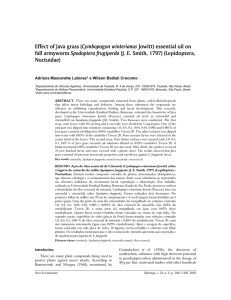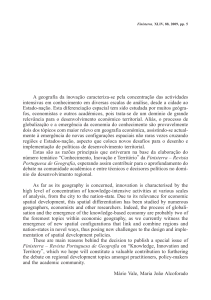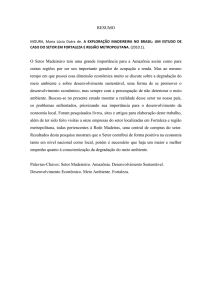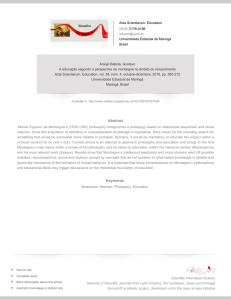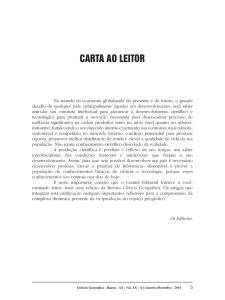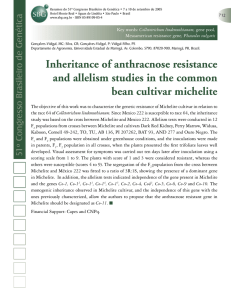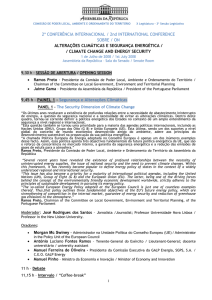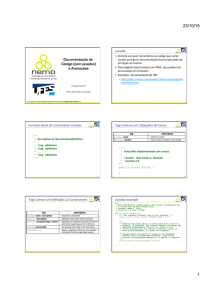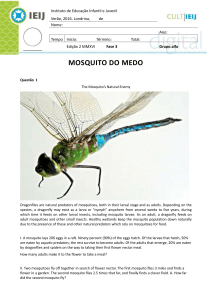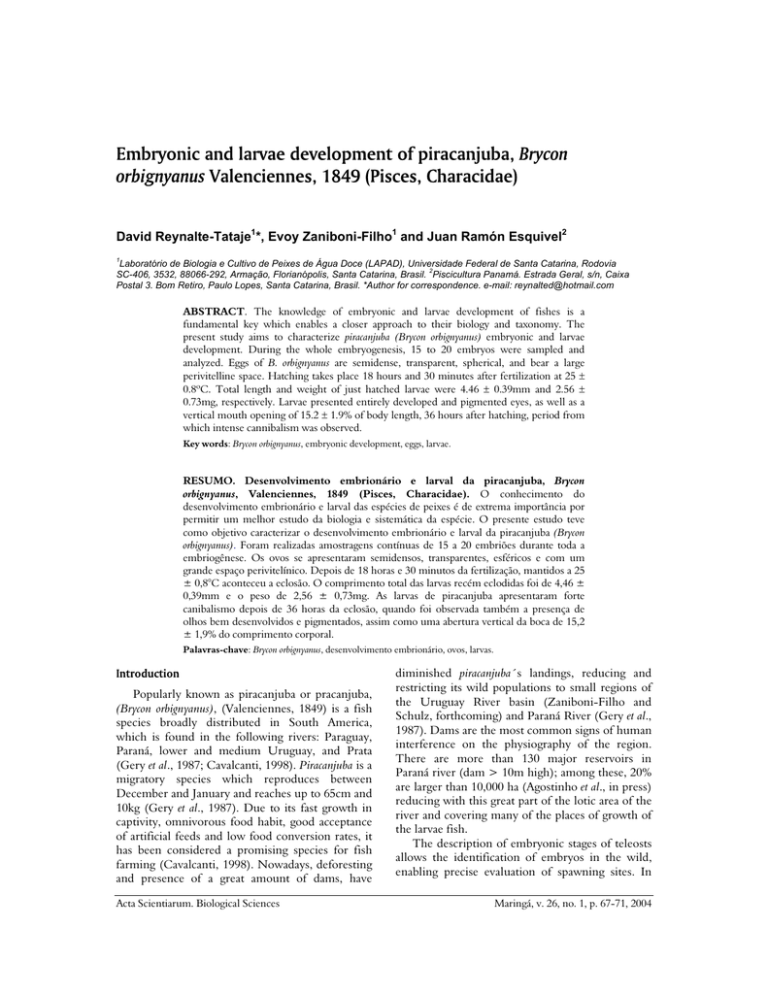
Embryonic and larvae development of piracanjuba, Brycon
orbignyanus Valenciennes, 1849 (Pisces, Characidae)
David Reynalte-Tataje1*, Evoy Zaniboni-Filho1 and Juan Ramón Esquivel2
1
Laboratório de Biologia e Cultivo de Peixes de Água Doce (LAPAD), Universidade Federal de Santa Catarina, Rodovia
2
SC-406, 3532, 88066-292, Armação, Florianópolis, Santa Catarina, Brasil. Piscicultura Panamá. Estrada Geral, s/n, Caixa
Postal 3. Bom Retiro, Paulo Lopes, Santa Catarina, Brasil. *Author for correspondence. e-mail: [email protected]
ABSTRACT. The knowledge of embryonic and larvae development of fishes is a
fundamental key which enables a closer approach to their biology and taxonomy. The
present study aims to characterize piracanjuba (Brycon orbignyanus) embryonic and larvae
development. During the whole embryogenesis, 15 to 20 embryos were sampled and
analyzed. Eggs of B. orbignyanus are semidense, transparent, spherical, and bear a large
perivitelline space. Hatching takes place 18 hours and 30 minutes after fertilization at 25 ±
0.8ºC. Total length and weight of just hatched larvae were 4.46 ± 0.39mm and 2.56 ±
0.73mg, respectively. Larvae presented entirely developed and pigmented eyes, as well as a
vertical mouth opening of 15.2 ± 1.9% of body length, 36 hours after hatching, period from
which intense cannibalism was observed.
Key words: Brycon orbignyanus, embryonic development, eggs, larvae.
RESUMO. Desenvolvimento embrionário e larval da piracanjuba, Brycon
orbignyanus, Valenciennes, 1849 (Pisces, Characidae). O conhecimento do
desenvolvimento embrionário e larval das espécies de peixes é de extrema importância por
permitir um melhor estudo da biologia e sistemática da espécie. O presente estudo teve
como objetivo caracterizar o desenvolvimento embrionário e larval da piracanjuba (Brycon
orbignyanus). Foram realizadas amostragens contínuas de 15 a 20 embriões durante toda a
embriogênese. Os ovos se apresentaram semidensos, transparentes, esféricos e com um
grande espaço perivitelínico. Depois de 18 horas e 30 minutos da fertilização, mantidos a 25
± 0,8°C aconteceu a eclosão. O comprimento total das larvas recém eclodidas foi de 4,46 ±
0,39mm e o peso de 2,56 ± 0,73mg. As larvas de piracanjuba apresentaram forte
canibalismo depois de 36 horas da eclosão, quando foi observada também a presença de
olhos bem desenvolvidos e pigmentados, assim como uma abertura vertical da boca de 15,2
± 1,9% do comprimento corporal.
Palavras-chave: Brycon orbignyanus, desenvolvimento embrionário, ovos, larvas.
Introduction
Popularly known as piracanjuba or pracanjuba,
(Brycon orbignyanus), (Valenciennes, 1849) is a fish
species broadly distributed in South America,
which is found in the following rivers: Paraguay,
Paraná, lower and medium Uruguay, and Prata
(Gery et al., 1987; Cavalcanti, 1998). Piracanjuba is a
migratory species which reproduces between
December and January and reaches up to 65cm and
10kg (Gery et al., 1987). Due to its fast growth in
captivity, omnivorous food habit, good acceptance
of artificial feeds and low food conversion rates, it
has been considered a promising species for fish
farming (Cavalcanti, 1998). Nowadays, deforesting
and presence of a great amount of dams, have
Acta Scientiarum. Biological Sciences
diminished piracanjuba´s landings, reducing and
restricting its wild populations to small regions of
the Uruguay River basin (Zaniboni-Filho and
Schulz, forthcoming) and Paraná River (Gery et al.,
1987). Dams are the most common signs of human
interference on the physiography of the region.
There are more than 130 major reservoirs in
Paraná river (dam > 10m high); among these, 20%
are larger than 10,000 ha (Agostinho et al., in press)
reducing with this great part of the lotic area of the
river and covering many of the places of growth of
the larvae fish.
The description of embryonic stages of teleosts
allows the identification of embryos in the wild,
enabling precise evaluation of spawning sites. In
Maringá, v. 26, no. 1, p. 67-71, 2004
Reynalte-Tataje et al.
68
laboratories which massively produce fish
juveniles, through induced fertilization, the
previous knowledge of embryonic stages helps
incubation
management
with
regard
to
environmental variables which can lead to larvae
malformation and low productivity in captivity
(Alves and Moura, 1992).
Additionally, the knowledge of embryonic and
larvae stages of fishes which stocks are reduced, as
the piracanjuba, may be of great importance as a tool
to identify its main reproductive grounds and thus,
to guide environmental conservation planning and
management.
Material and methods
Piracanjuba livestock was kept for 3 years in
2.000m2 earth ponds of a Panamá Fish Hatchery,
located in Paulo Lopes municipality, state of Santa
Catarina, Brazil. The selection of broodstock took
place when animals presented gonad maturation
characteristics described by Woynarovich and
Horváth (1983). Selected animals were transported
to laboratory, where males and females were kept
separated in 500 liter tanks with water exchange
rate of 4 to 5 liters per minute.
The conventional method for gametogenesis
induction through injection of Carp Pituitary
Extract (CPE) was applied. All broodstock received
a preliminary dose of 0.25mgCPE/Kg (ZaniboniFilho and Barbosa, 1996) and 24 hours afterwards,
females received 0.5 and 5.0mgCPE/Kg with a 12
hour interval, while males received a single dose of
1.5mgCPE/Kg at the moment when the females
had received the second dose.
After 143 degree-hour (24,2°C) from the last
application, gametes were manually stripped and
mixed for fertilization. A sample of 5g of eggs was
placed into a 60L static hatching tank with a conical
shaped bottom, provided with an airstone. To
avoid variations of water temperature this tank was
place inside a bigger tank (200L) equipped with an
electrical heater and thermostat.
In order to observe and register different
embryonic developmental stages, 15 to 20 embryos
were sampled every 10 minutes within the first 5
hours, and then every 30 minutes until hatching.
During larvae development, 4 or 5 larvae were
sampled every 2 hours. Samples were made using
a 5mL pipette. Eggs and larvae were immediately
fixed in buffered 4% formaldehyde solution
(Nakatani et al., 2001).
Eggs were characterized according to the
following data: total diameter, yolk cell diameter
and perivitelline space diameter (between the
Acta Scientiarum. Biological Sciences
chorion and the yolk cell) (Nakatani et al., 2001).
The criteria for measurement and characterization
of just hatched larvae followed recommendations
made by Ahlstrom et al. (1976) and Leis and Trnski
(1989), while meristic characterization of just
hatched larvae was based on the number of pre
anal, post anal, and total myomeres. Yolk cell
volume was calculated according to Heming and
Buddington (1988).
The observation and identification of
embryonic stages were carried out at the Marine
Fish Laboratory of Federal University of Santa
Catarina. For such, a microscope coupled and a
printer were used.
Temperature and dissolved oxygen were
measured hourly with a YSI-55 oxymeter, while
pH, ammonia and nitrate concentrations were daily
measured through the colorimetrical method.
Results
The mean value of water temperature during
incubation was 25.0 ± 0.8ºC, although it slightly
decreased from the begging of the experiment from
25.9 to 24.0ºC in the end. Dissolved oxygen mean
concentration and pH values were of 7.34 ±
0.46mg/L and 7.4 to 8.1, respectively, while total
ammonia and nitrite concentrations were below
0.4mg/L and 0.01mg/L, respectively.
During incubation, the eggs of B. orbignyanus
were spherical, semidense, and transparent. The
fertilization moment was taken as the time zero.
After 10 minutes, the perivitelline space was
observed. The mean diameter of eggs, after
hydration, was of 3.46 ± 0.29mm. This egg
presents a large perivitelline space (0,71 ± 0,05
mm) what it corresponds to the 20,52% of its
participation of the total size of the egg. The main
morphological
events
registered
in
each
developmental stage of piracanjuba are briefed on
Table 1 and pictured on Figures 1 and 2.
Hatching of larvae occurred 18 hours and 30
minutes after fertilization, which correspond to
451 degree-hour. The percentage of fertilization
found in this work was 5%. Elongated on the
anterior-posterior axis, just hatched larvae
measured from 4.14 to 4.71mm (4.46±0.39mm) of
total length (Lt). The notochord is straight and
easily seen, as well as the large, rounded, fairly
pigmented and undeveloped eyes. The embryonic
membrane is hyaline and not pigmented, as well as
the emptied air-bladder. The intestine is
intermediate and closed. The yolk cell is relatively
large (0.62 ± 0.09mm3). The number of visible
myomeres ranged from 43 to 48 (27 to 29 pre anal
Maringá, v. 26, no. 1, p. 67-71, 2004
Embryonic development of Brycon orbignyanus
69
and 16 to 19 post anal). Just hatched larvae weighed
0.9 ± 0.1mg, and showed vigorous vertical
swimming.
After 10.5 hours from hatching, larvae opened
their mouth, while their digestive tract was clearly
delineated. Such larvae tract has entirely pigmented
eyes.
Piracanjuba larvae presented strong cannibalism
36 hours after hatching, even showed some yolk.
At this stage, otoliths were verified, eyes were well
developed and mouth had a vertical opening of
15.2 ± 1.9% of body length. Furthermore, larvae
presented conical teeth, complete digestive tract
and greenish ventral portion.
Table 1. Description and timing of Brycon orbignyanus main
embryonic morphological events. Incubation temperature of 25.0
±0.8ºC.
Stage
Time
Description
Figure
1. Formation of
blastodisk
0.25
HAF1
Formation of animal and vegetal
poles. Telolecithal eggs. The first
cleavage occurs after 30 minutes
from fertilization. Until the next
hour, the 32 blastomeres are already
formed.
1A
2. Lower
blastula
2.0
HAF1
Complete formation of blastula.
Blastodisk still in cleavage.
3. Higher
blastula
4.0
HAF1
Flattening of blastomeres.
4. Gastrulation
1B
Blastoderm begins to surround the
5.0
yolk. Invagination of endoderm and
HAF1
ectoderm. Formation of blastopore.
5. Closure of
blastopore
6.5
HAF1
Fusion of blastodisk lips.
Delimitation of the embryo body
and the yolk cell.
6. Beginning of
organogenesis
7.5
HAF1
Beginning of head and tail
differentiation.
1C
Total differentiation between
9.5
cephalic and caudal zones. Presence
HAF1
of eye vesicles.
1D
8. Otoliths and
olfactory
orifices
15.5
HAF1
Presence of olfactory orifices and
otoliths in the auditory vesicle.
2A
9. Hatching
18.5
HAF1
Vigorous embryo movements and
hatching. Larvae present eye ball
traces. Total length (Lt) of 4.46mm.
2B
7. Eye vesicle
10. Larvae with
yolk cell
Larvae bear straight ended
notochord.
10.1.
Mouthopening
10.5
HAH2
Larva lengths (Lt) 5.65 ± 0.12mm
when its mouth opens.
10.2 Teeth
22.0
HAH2
Appearance of a little conical teeth
36.0
HAH2
Post-larva lengths (Lt) 5.65 ±
0.12mm.
11.1 Beginning
of
cannibalism
Figure 1. Phases of embryonic development of piracanjuba (Brycon
orbignyanus). A. Cleavage of blastodisk (8 blastomeres); B. Lower
blastula, flattening of blastomeres; C. Closure of blastopore; D.
Head (Hd) and tail (Tl) differentiation. (Bar = 1.0mm)
1
HAF = hours after fertilization; 2HAH = hours after hatching.
Acta Scientiarum. Biological Sciences
2C
2D
Figure 2. Phases of embryonic development of piracanjuba
(Brycon orbignyanus). A. Embryo just before hatching; B. Just
hatched larvae; C. Mouth opening; D. Larvae 36 hours after
hatching, beginning of cannibalistic behavior. (Bar = 1.0mm)
Discussion
Piracanjuba (Brycon orbignyanus) eggs present
similar characteristics to those found in other species
(Brycon cephalus, Brycon insignis) belonging to the
same genus, such as the total diameter and the large
perivitelline space (Bernardino et al., 1993; AndradeTalmelli, 1997; Andrade-Talmelli et al., 2001).
Further on genus Brycon this characteristic is
common for migratory species, such as curimbata
(Prochilodus lineatus) (Curiacos, 1999), Salminus
brasiliensis (Morais Filho and Schubart, 1955) and
Leporinus obtusidens (Nakatani et al., 2001).
According to Nakatani et al. (2001), the
perivitelline space is considered large, when
occupied between 20 and 29.9% of the total volume
of the egg. A large perivitelline space is believed to
enhance the embryo survival, protecting it from
mechanical injuries (Andrade–Talmelli, 1997).
Maringá, v. 26, no. 1, p. 67-71, 2004
Reynalte-Tataje et al.
70
It has been observed in the Brycon genus free and
semidense eggs, with slight difference in colors,
varying from green (B. insignis and B. lundii), pale
purple (B. lundii) to gray or wine (B. cf. reinhardti)
(Andrade-Talmelli, 1997). In this work, (Brycon
orbignyanus) egg was greenish, being this color
dominant in the yolk cell until it was fully
consumed. Similar observations were described for
other species of the Brycon genus (Lopes et al., 1995;
Andrade–Talmelli, 1997), as well as for Salminus
maxillosus larvae (Morais Filho and Schubart, 1955).
In vitro reproduction of B. orbignyanus has led
to low fertilization rates, usually inferior to 50%
(Belmont, 1994) and 12.8% (Zaniboni-Filho and
Barbosa, 1996). In the present study, a rather lower
rate of 5% was achieved.
The morphological events registered during
piracanjuba´s embryogenesis are similar to those
found in other neotropical freshwater fishes
(Godinho et al., 1978; Sato 1999). The relatively
short embryogenesis period and the single spawning
of free eggs are also common characteristics in
neotropical migrant fishes which migrate to
reproduce. According to Lopes et al. (1995), eggs of
B. cephalus hatch after 10.5 hours, when incubated at
30ºC. Morais Filho and Schubart (1955) observed
the embryogenesis of S. maxillosus, registering an
incubation period of 23 hours for temperatures
between 23 and 24ºC and a mean Lt of 4.8mm.
Regarding incubation temperatures, Curiacos
(1999) found for Prochilodus scrofa = P. lineatus that
the time required for hatching at 23ºC is almost
twice the time needed at 29ºC. Sato (1999), working
with Prochilodus affinis, registered an embryonic
development time of 20 hours at a mean
temperature of 23.5ºC.
In the present work, hatching began after 18.5
hours after the fertilization of eggs, however the last
larvae hatched 3 hours later. For a temperature of
25.0±0.8ºC, piracanjuba´s larvae assumed a
cannibalistic behavior, 36 hours after hatching, even
bearing some yolk. This behavior, as well as the
morphological features described, at this time,
matches with what Ceccarelli (1997) described for
B. cephalus 38 hours after hatching. According to
some authors, the cannibalism during larvae stages
observed in the genus Brycon is the main problem
found in its larviculture management (Woynarovich
and Sato, 1989; Bernardino et al., 1993).
Fox (1975) has posted that cannibalism is a
common behavior in the animal kingdom. For
fishes, cannibalism usually occurs within a
heterogeneous-sized population, in situations of
scarcity of feed, high stocking densities, short of
Acta Scientiarum. Biological Sciences
shelter and light and dark conditions (Hecht and
Pienaar, 1993).
References
AHLSTROM, E. H. et al. Pelagic stromateoid fishes
(Pisces, Perciformes) of the Eastern Pacific: kinds,
distributions, and early life histories and observations on
five of these from the Northwest Atlantic. Bull. Mar. Sci.
Gembloux, ,v.26, n.3, p.285-402, 1976.
ALVES, M. S. D.; MOURA, A. Estádios de
desenvolvimento embrionário de curimatã-pioa Prochilodus
affinis (Reinhardt, 1874) (Pisces, Prochilodontidae) em
1992. In: ENCONTRO ANUAL DE AQUICULTURA
DE MINAS GERAIS, 1992, Belo Horizonte. Anais... Belo
Horizonte, Três Marias: CODEVASF, 1992. p. 61 – 71.
ANDRADE-TALMELLI, E. F. et al. Embryonic and
larvae development of the “piabanha”, Brycon insignis,
STEINDACHNER, 1876 (PISCES, CHARACIDAE).
Boletim do Instituto de Pesca, São Paulo, v.27, n.1, p. 21-28,
2001.
ANDRADE-TALMELLI, E. F. Indução reprodutiva e
ontogenia inicial da piabanha, Brycon insignis (Steindachner,
1876) (Characiformes, Bryconinae), mantida em confinamento –
Vale do Paraíba, SP. 1997. Tese (Doutorado) Universidade Federal de São Carlos, São Carlos,1997.
BALON, E. K. Reproductive guilds of fishes: a proposal
and definition. J. Fish. Res. Board. Can., Ottawa, v.32, n.6,
p.821–864, 1975.
BELMONT, R. A. F. Considerações sobre a propagação
artificial da piracanjuba, (Brycon orbignyanus) – CEP em
1994. In: SEMINÁRIO SOBRE CRIAÇÃO DE
ESPÉCIES DO GÊNERO Brycon, 1994, Pirassununga.
Anais... Pirassununga, SP, 1994. p.17–18.
BERNARDINO, G. et al. Propagação artificial do
matrinxã, Brycon cephalus (GÜNTHER, 1869) (Teleostei,
Characidae). Boletim Técnico do. CEPTA, Pirassununga,
v.6, n.2, p.1-9, 1993.
CAVALCANTI, C. de A., Proteases digestivas em juvenis de
piracanjuba ((Brycon orbignyanus) Eigenmann, 1909) e
aplicações da técnica de digestibilidade “in vitro”. 1998.
Dissertação (Mestrado) - Universidade Federal de Santa
Catarina, Florianópolis, 1998.
CECCARELLI, P. S. Canibalismo de larvas de Matrinxã,
Brycon cephalus, (Günther, 1869). 1997. Dissertação
(Mestrado) - Universidade Estadual Paulista “Julio
Mesquita Filho”, Botucatu, 1997.
CURIACOS, A. P. J. Efeito da temperatura no desenvolvimento
inicial de larvas de “curimbata” Prochilodus scrofa Steindachner,
1881 (Characiformes, Prochilodontidae). 1999. Dissertação
(Mestrado) - Universidade Federal de Santa Catarina,
Florianópolis, 1999.
FOX, L. R. Cannibalism in natural populations. Ann. Rev.
Ecol. Syst., London, v.6, p.87-106, 1975.
GERY, J. et al. Poissons characoides non Characidae du
Paraguay (Pisces, Ostariophysi). Rev. Suisse Zool., Geneve,
v.94, n.2, p.357-464, 1987.
Maringá, v. 26, no. 1, p. 67-71, 2004
Embryonic development of Brycon orbignyanus
GODINHO, H. M. et al. Desenvolvimento embrionário e
larvae de Rhamdia hilarii (Valenciennes, 1840)
(Siluriformes, Pimelodidae). Rev. Bras. Biol., Rio de
Janeiro, v.38, n.1, p.151-156, 1978.
HECHT, T.; PIENAAR, G. A. Review of cannibalism
and its implications in fish larviculture. J. World Aquacult.
Soc., Lousianna, v.24, n.2, p. 247-261, 1993.
HEMING, T. A.; BUDDINGTON, R. K. Yolk
absorption in embryonic and larvae fishes. In: HOAR, W.
S.; RANDALL, D. J. (Ed.) Fish Physiology, Boston:
Academic Press, 1988. v. 11A. cap. 5, p. 407-446.
LEIS, J. M.; TRNSKI, T. The larvae of Indo-Pacific
shorefishes. Honolulu: University of Hawaii Press, 1989.
LOPES, R. N. M. et al. Desenvolvimento embrionário e
larvae do matrinxã Brycon cephalus Günther, 1869, (Pisces,
Characidae). Boletim Técnico do CEPTA., Pirassununga,
v.8, p.25-39, 1995.
MORAIS FILHO, M. B.; SCHUBART, O. Contribuição
ao estudo do dourado, (Salminus maxillosus Val.) do Rio Mogi
Guassu (Pisces, Characidae). São Paulo: Ministério de
Agricultura, 1955.
NAKATANI, K. et al. Ovos e larvas de peixes de água doce.
Desenvolvimento e manual de identificação. Maringá: Eduem,
2001.
Acta Scientiarum. Biological Sciences
71
SATO, Y. Reprodução de peixes da bacia rio São Francisco:
Indução e caracterização de padrões. 1999. Tese (Doutorado) Universidade Federal de São Carlos, São Carlos, 1999.
WOYNAROVICH, E.; HORVÁTH, L. A propagação
artificial de peixes de águas tropicais - Manual de Extensão.
Brasília: FAO/CODEVASF/CNPq, 1983.
WOYNAROVICH, E.; SATO, Y. Special rearing of larvae
and post-larvae of matrinxã (Brycon lundii) and dourado
(Salminus brasiliensis). In: HARVEY, B.; CAROSFELD.
(Ed.) Workshop on larvae rearing of finfish. Ottawa: CIDA,
ICSU, CASAFA, 1989. v. 1, p.134-136.
ZANIBONI-FILHO, E.; SCHULZ, U. H. Migratory
fishes of the Uruguay river. In: CAROLSFELD, J. et al.
Migratory fishes of South America. Biology, Social Importance
and Conservation Status. Washington D.C: The World
Bank. cap. 3, p. 124-156 (in press).
ZANIBONI-FILHO, E.; BARBOSA, N. D. C. Priming
hormone administration to induce spawning of brazilian
migratory fish. Rev. Bras. Biol, Rio de Janeiro, v.56, n.4,
p.655–659, 1996.
Received on September 26, 2003.
Accepted on March 08, 2004.
Maringá, v. 26, no. 1, p. 67-71, 2004

